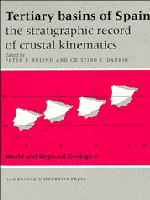Book contents
- Frontmatter
- Contents
- List of contributors
- Preface
- Dedication to Professor Oriol Riba IArderiu
- Memorial, Etienne Moissenet 1941–1994
- PART G GENERAL
- PART E EAST
- PART W WEST
- W1 The Duero Basin: a general overview
- W2 Alpine tectonic framework of south-western Duero basin
- W3 South-western Duero and Ciudad Rodrigo basins: infill and dissection of a Tertiary basin
- W4 Tectono-sedimentary evolution of the Almazán Basin, NE Spain
- W5 Tertiary basins and Alpine tectonics in the Cantabrian Mountains (NW Spain)
- W6 Lacustrine Neogene systems of the Duero Basin: evolution and controls
- W7 North-western Cainozoic record: present knowledge and the correlation problem
- W8 Onshore Cenozoic strike–slip basins in NW Spain
- W9 Tertiary of Central System basins
- PART C CENTRE
- PART S SOUTH
- Index
W2 - Alpine tectonic framework of south-western Duero basin
Published online by Cambridge University Press: 04 August 2010
- Frontmatter
- Contents
- List of contributors
- Preface
- Dedication to Professor Oriol Riba IArderiu
- Memorial, Etienne Moissenet 1941–1994
- PART G GENERAL
- PART E EAST
- PART W WEST
- W1 The Duero Basin: a general overview
- W2 Alpine tectonic framework of south-western Duero basin
- W3 South-western Duero and Ciudad Rodrigo basins: infill and dissection of a Tertiary basin
- W4 Tectono-sedimentary evolution of the Almazán Basin, NE Spain
- W5 Tertiary basins and Alpine tectonics in the Cantabrian Mountains (NW Spain)
- W6 Lacustrine Neogene systems of the Duero Basin: evolution and controls
- W7 North-western Cainozoic record: present knowledge and the correlation problem
- W8 Onshore Cenozoic strike–slip basins in NW Spain
- W9 Tertiary of Central System basins
- PART C CENTRE
- PART S SOUTH
- Index
Summary
Abstract
The tectonic activity in the south-western area of the Spanish Northern Meseta (Ciudad Rodrigo and Duero basins) during most of the Tertiary was determined by a transpressive regime that reactivated Hercynian to Late-Hercynian faults. The record of the Alpine Orogeny is complex because the sedimentary record indicates a compressive regime in the source areas coeval with the extensional to transpressive regime indicated by normal or strike-slip faults. This duality is due to the geotectonic position of this area between two compressive areas, the Cantabrian Range and the Central System, and the extensional Atlantic margin.
Introduction
The Duero basin is an intracontinental basin of cratonic type (sensu Sloss & Speed, 1974) bounded by mountain ranges that evolved relatively independently during the Tertiary (Fig. 1).
The northern border is the Cantabrian Mountains, made up of Mesozoic and Palaeozoic rocks affected by thrusts and low-angle reverse faults. Its history is related to the Alpine evolution of the Pyrenees.
The eastern border is the Iberian Range that extends between the Pyrenees and the Betics, the main Spanish compressive orogens.
The southern border is the Central System, bounded by high-angle reverse and strike-slip faults of Hercynian to Late Hercynian age, reactivated during Alpine Orogeny.
The western border is the Palaeozoic metasedimentary and igneous rocks of the western Spanish Meseta. It has a relatively passive tectonic history but was affected by the evolution of the Atlantic margin.
- Type
- Chapter
- Information
- Tertiary Basins of SpainThe Stratigraphic Record of Crustal Kinematics, pp. 188 - 195Publisher: Cambridge University PressPrint publication year: 1996
- 1
- Cited by



